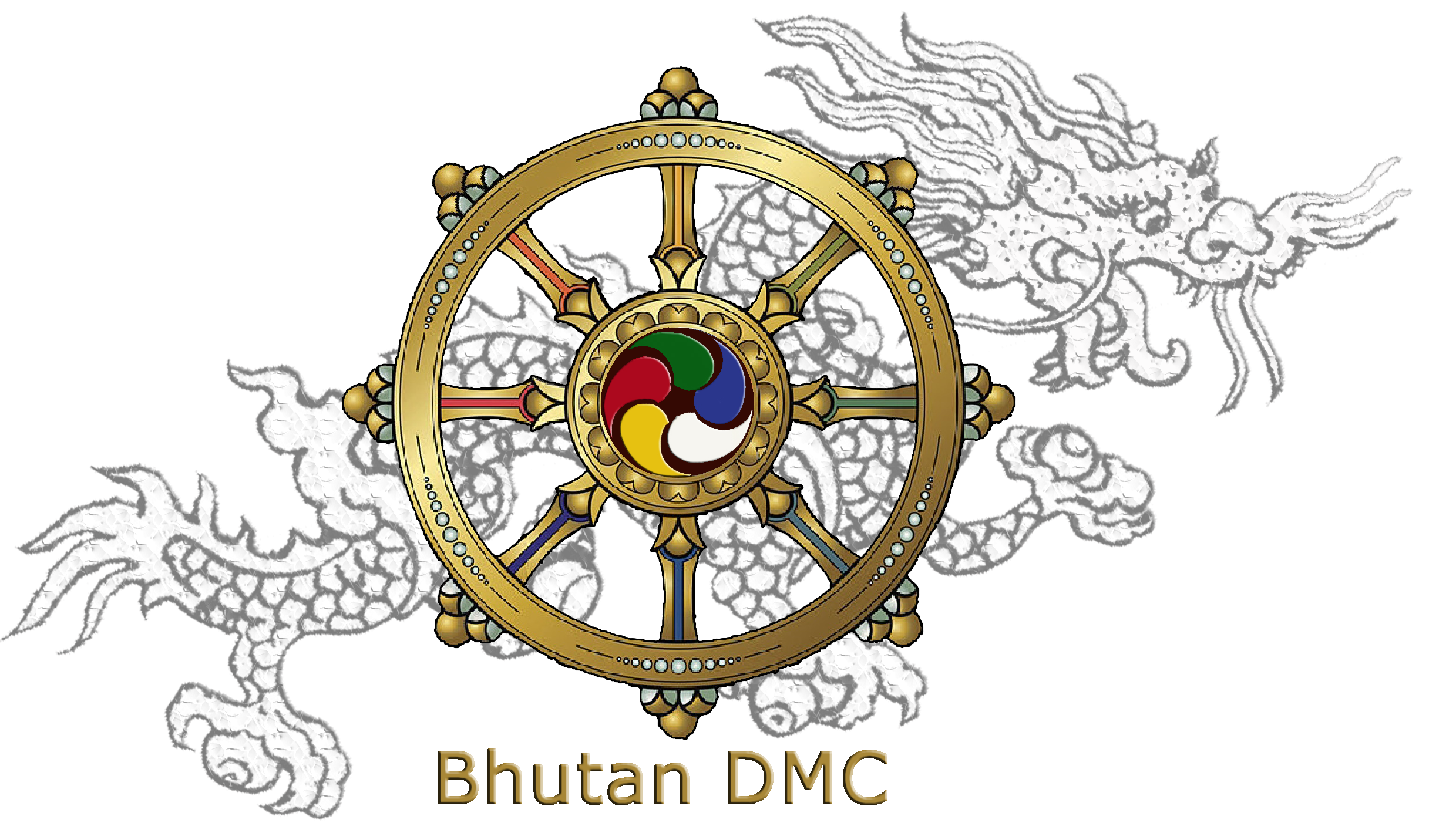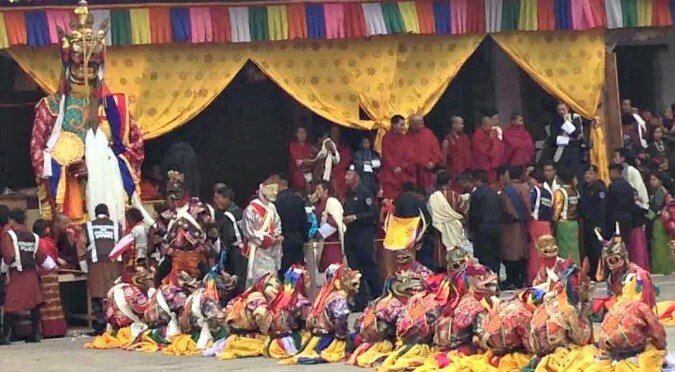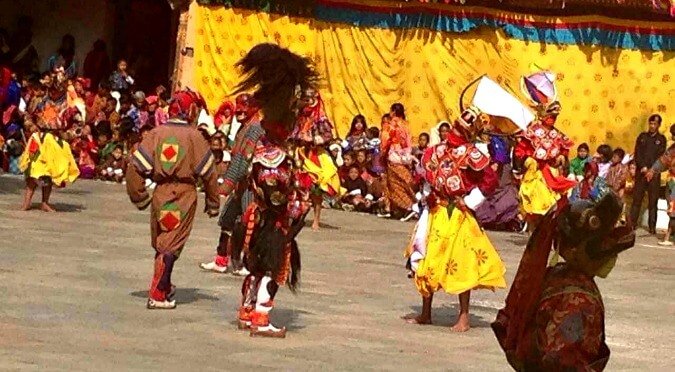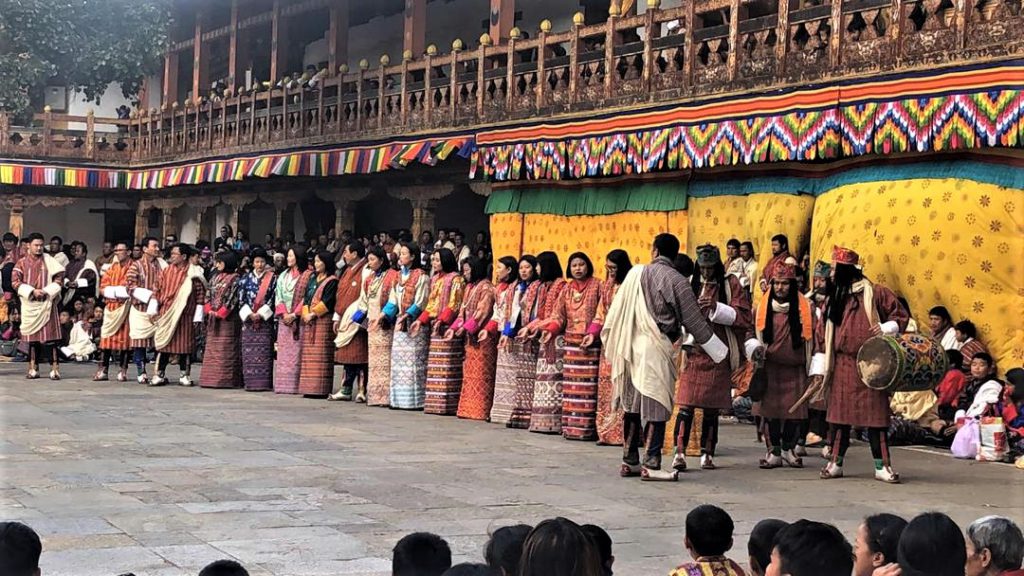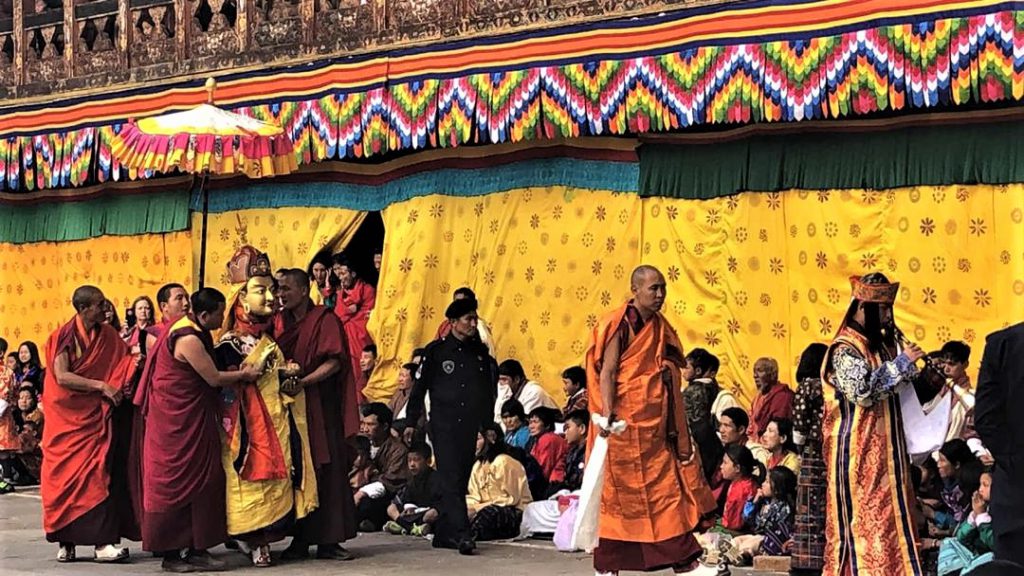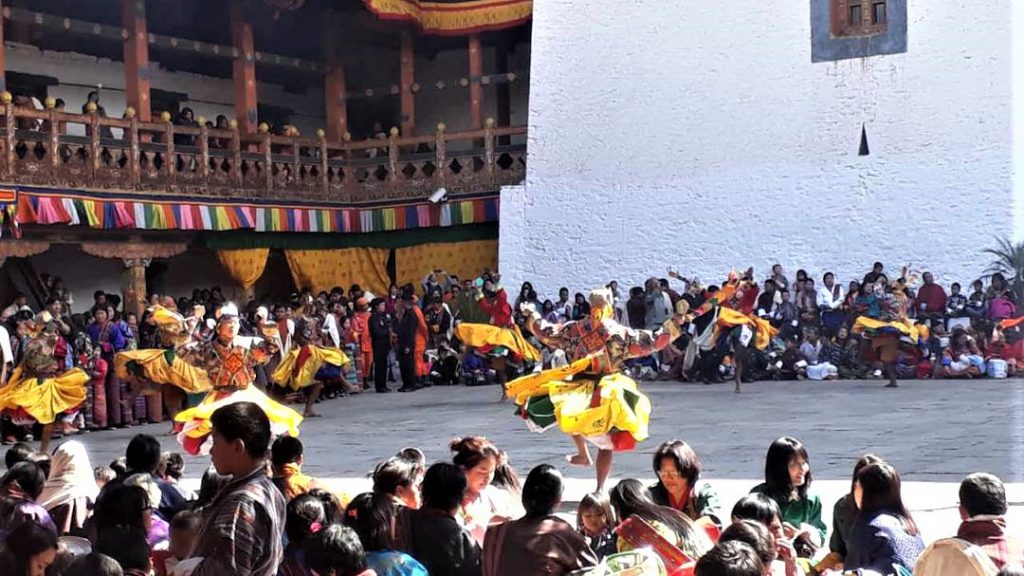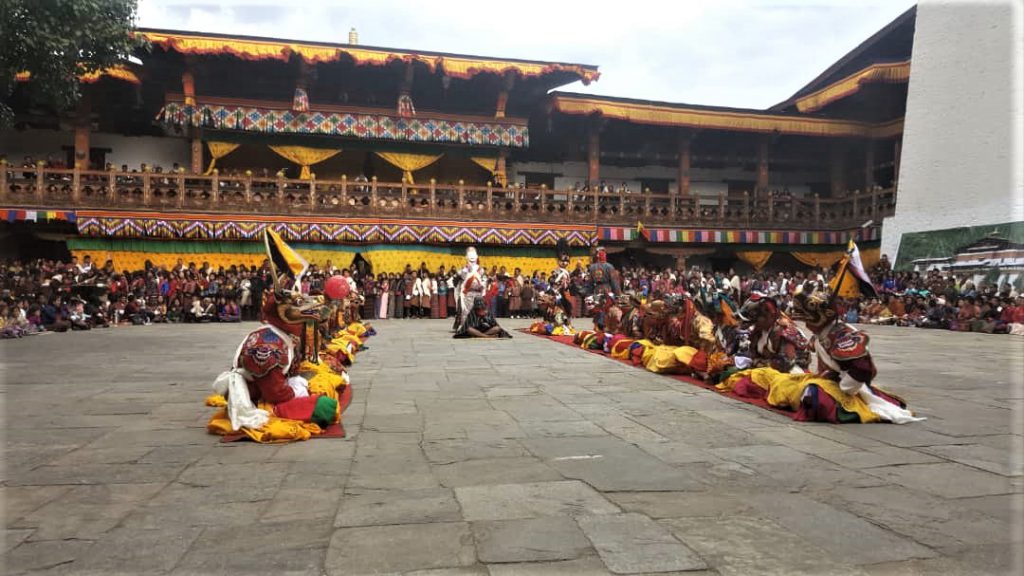Punakha located in the western part of Bhutan, is the winter home of the Je Khenpo, the Chief Abbot of the country. It has been of great importance since the time of Zhabdrung Ngawang Namgyel in 17th century who is regarded as unifier of Bhutan. During Punakha festival, you will see locals dressed in their finest clothes who have walked for miles to attend the festivities. They come to watch masked dances, to pray, and to feast. While the underlying purpose of the festival is spiritual, it is a unique festival in Bhutan showcasing dramatic action of Zhabdrung Nyawang Namgyel in 17th century victory against Tibetan invasion and highlighting the life of Bhutan’s patron saint, Padmasambhava (also known as Guru Rinpoche).
Day 1
Arrive Paro by Flight & Transfer to Thimphu
The flight to Paro is one of the most spectacular in entire Himalayas. Flying along the Himalayan range from Kathmandu or over Himalayan foothills, the journey offers fascinating views and an exciting descent into the Kingdom. Bhutan’s first gift to you as you disembark from the aircraft will be cool, clean fresh mountain air. After immigration formalities and baggage collection, you will be met by our representative, and afterwards drive to Thimphu, the capital town of Bhutan
On arrival, in Thimphu check-into the hotel. The capital town of Bhutan and the centre of government, religion and commerce, Thimphu is a unique city with unusual mixture of modern development alongside ancient traditions. With the population of about 1,00,000 it is perhaps still the world’s only capital city without a traffic light.
Later in the day take an exploratory walk around local market place located a few minutes’ walk from hotels. Or take a walk to local craft Bazar recently established under patronage of Department of cottage & small industry and in collaboration with the Department of culture, Tourism council and the Department of agriculture marketing and cooperatives, this market offers genuine Bhutanese arts & crafts thus contributing in promotion, protection and preservation of traditional arts.
Overnight at the hotel in Thimphu. (Altitude 2,320m)
Day 2
Thimphu After breakfast, proceed for the guided tour of city’s main attractions that includes: Textile Museum: It is worth a visit to get to know the living national art of weaving. Exhibitions introduce the major weaving techniques, styles of local dress and textiles made by women and men. National Library: The history of Bhutan lies imprinted in archaic texts, which are preserved at the National Library. Besides thousands of manuscripts and ancient texts, the library also has modern academic books and printing blocks for prayer flags. Institute for Zorig Chusum: Commonly known as Arts & Crafts School or Painting School, the Institute offers a six-year course on the 13 traditional arts and crafts of Bhutan. On a visit, one can see students learning the various skills taught at the school. (Institute of Zorig Chusum remains close in June-Aug & mid Nov-Feb, alternative Changangkha Lhakhang tour can be arranged) Changangkha Lhakhang: It is a fortress like temple and monastic school perched on a ridge above Thimphu, south of Motithang. The temple was established in 12th century on a site chosen by Lama Phajo Drugom Shigpo, who came from Tibet. The central statue here is Chenrezig in a manifestation with 11 heads. From temple courtyard, there is fascinating view of Thimphu valley. Simply Bhutan Museum: The newly commissioned museum depicts the ancient Bhutanese architecture which is being lost to modernization. The uniqueness of the structure is in its composition of the materials used. The structure is built reusing old timber, window and door frames and other items from traditional and old demolished houses. The best part is the portrayal of the age-old lifestyles of the Bhutanese people. Lunch followed by city tour that includes: Memorial Chorten: The stupa built in the memory of Bhutan’s third King, His Late Majesty, King Jigme Dorji Wangchuk, who is popularly regarded as Father of modern Bhutan. The paintings and statues inside the monument provide a deep insight into Buddhist philosophy. Buddha Point (Kuensel Phodrang). Located at a short drive from Thimphu city centre, visitors can get a good overview of the Thimphu valley from the Buddha point (Kuensel Phodrang). You can pay your obeisance and offer prayers to the Buddha, the largest statue in the country and then walk around and take a glimpse of the valley. Conclude the tour of the day with a visit of Trashichhoedzong, ‘fortress of the glorious religion’. This is the center of government and religion, site of monarch’s throne room and seat of Je Khenpo or Chief Abbot. Built in 1641 by the political and religious unifier of Bhutan, Shabdrung Ngawang Namgyal, it was reconstructed in 1960s in traditional Bhutanese manner, without nails or architectural plans. Overnight at the hotel in Thimphu. (Altitude 2,320m)
Day 3
Thimphu – Gangtey (150 km, approx. 5-hour drive) After breakfast enjoy a dramatic drive over the high mountain pass of Dochu La (3,088m) and on to the Phobjikha Valley passing through dense forests and oak, rhododendron tress. After checking into hotel, explore Gangtey village and Phobjikha valley on foot. The valley of Gangtey is one of the most beautiful spots in Bhutan. The surprise of finding such a wide, flat valley without any trees after the hard climb through dense forests is augmented by an impression of vast space, and extremely rare experience in Bhutan where most of the valleys are tightly enclosed. A few kilometers beyond the Gangtey Monastery, on the valley floor lies the village of Phobjikha. This place is the winter home of black necked cranes that migrate from the arid plains in the north to pass winter in milder and lower climate. Phobjikha, at an altitude of 2900 m, falls under the district of Wangduephodrang and lies on the periphery of the Black Mountain National Park. Explore Phobjikha valley for Black Necked Cranes. (in winter only, Nov to Feb) Later visit Gangtey Gompa. Perched on a small hill that rises from the valley floor, the Gangtey Monastery is the only Nyingmapa monastery on the western side of the Black Mountain’s and also the biggest Nyingmapa monastery in Bhutan. The Monastery is surrounded by a large village inhabited mainly by the families of the 140 Gomchens who take care of the Monastery. Overnight at the hotel in Gangtey. (Altitude 3,000m)
Day 4
Gangtey – Punakha (85 km, approx. 3-hour drive) After a hearty breakfast time to head back to Punakha. Later in the day, proceed to visit Punakha Dzong (the ‘Palace of Great Happiness’), a massive structure built at the junction of two rivers. Built in the 17th century by Zhabdrung Ngawang Namgyal (who founded the Kingdom of Bhutan), the fortress once housed the country’s government. It is now the winter home of Je Khenpo, the head abbot of Bhutan, along with a retinue of 1,000 monks. Afterwards a short walk across farmhouses and rice paddies takes you to Chimi Lhakhang, a 15th-century fertility temple dedicated to Drukpa Kuenley, a Tibetan Buddhist saint, popularly better known as the ‘Divine Madman’. This site has long been a pilgrimage for couples hoping to start a family. Overnight at the hotel in Punakha. (Altitude 1300m)
Day 5
Punakha Today, full day witness Punakha festival. Punakha holds two festivals; Punakha Drubchen is a unique festival because it hosts a dramatic recreation of the scene from the 17th century battle with Tibetan army. The ‘pazaps’ or local militia men, dress in traditional battle gear and re-enact the ancient battle scene. This re-enactment harkens back to the time when in the absence of a standing army, men from the eight Tshogchens or great village blocks of Thimphu came forward and managed to expel the invading forces from the country. Their victory ushered in a period of new-found internal peace and stability. While Punakha Tshechu was introduced in 2005 by the 70th Je Khenpo Trulku Jigme Choedra and the then Home Minister, His Excellency Lyonpo Jigme Yoedzer Thinley. The Tshechu was introduced in response to the requests made by Punakha District Administration and local people to host a Tshechu in order to better preserve Buddhist teachings and keep alive the noble deeds of Zhabdrung Rimpoche. These two festivals not only play an important role in preserving Bhutan’s rich culture and traditions but also provide devout Buddhists with an opportunity for prayer and pilgrimage. Overnight at the hotel in Punakha. (Altitude 1300m)
Day 6
Punakha – Paro (125 Km, approx. 4-hour drive) After breakfast depart to Paro, the road climbs steeply through a forest of pine and cedar, festooned with hanging lichen high up near Dochula pass. After a short stop at Dochula, drive further en route visiting Simtokha Dzong, the place of profound tantric teaching, this dzong now houses a school for the study of the Dzongkha language. Driving further to Chuzom (the confluence of the rivers Wang Chhu and Paro Chhu), you can glimpse the three nearby shrines, built to ward off evil spirits – each with a different style of architecture: Nepalese, Tibetan and Bhutanese. On arrival check into hotel. Later in the day set out on an exploratory excursion in around Paro valley. Visit Ta Dzong, originally built as a watchtower, which now houses the National Museum. The extensive collection includes antique thangkha paintings, textiles, weapons & armor, household objects and a rich assortment of natural and historic artifacts. Then walk down the trail to visit Rinpung Dzong, meaning (“fortress of the heap of jewels”), which has a long and fascinating history. Along the wooden galleries lining the inner courtyard are fine wall paintings illustrating Buddhist lore such as four friends, the old man of long life, the wheel of life, scenes from the life of Milarepa, Mount. Sumeru and cosmic Mandala. Part of Bernardo Bertolucci’s movie, ‘Little Buddha,’ was filmed inside this dzong. Overnight at the hotel in Paro. (Altitude 2,280m)
Day 7
Paro After breakfast, embark on a walking excursion to Taktshang Monastery (approx. 5 hours, round trip walk): It is one of the most famous of Bhutan’s monasteries, perched on the side of a cliff 900m above the Paro valley floor. It is said that Guru Rinpoche arrived here on the back of a tigress and meditated at this monastery and hence it is also called ‘Tiger’s Nest’. This site has been recognised as a most sacred place and visited by Shabdrung Ngawang Namgyal in 1646 and now visited by all Bhutanese at least once in their lifetime. Late afternoon, drive end of the Valley to the base of Drukgyel Dzong, a 17th century fortress burned down in the early 50s. Here we will also see the beautiful typical farmhouse. Bhutanese farmhouses are very colorful, decorative and traditionally built without the use of single nail. The majority of the population of Bhutan continues to live as it has for centuries – in small isolated farms and hamlets, surrounded by terraced fields of rice, maize and buckwheat. While driving to Paro town, stop en route at the 7th century Kyichu Lhakhang, one of the 108 temples built in the Himalayas by Tibetan King, Songtsen Gampo. The building of this temple marks the introduction of Buddhism in Bhutan. Evening an exploratory walk around main street and market area. Overnight at the hotel in Paro. (Altitude 2280m)
Day 8
Depart Paro by Flight After breakfast at the hotel, drive to the airport for the flight to your onward destination. Our representative will help you with exit formalities and then bid you farewell.
Image Gallery
